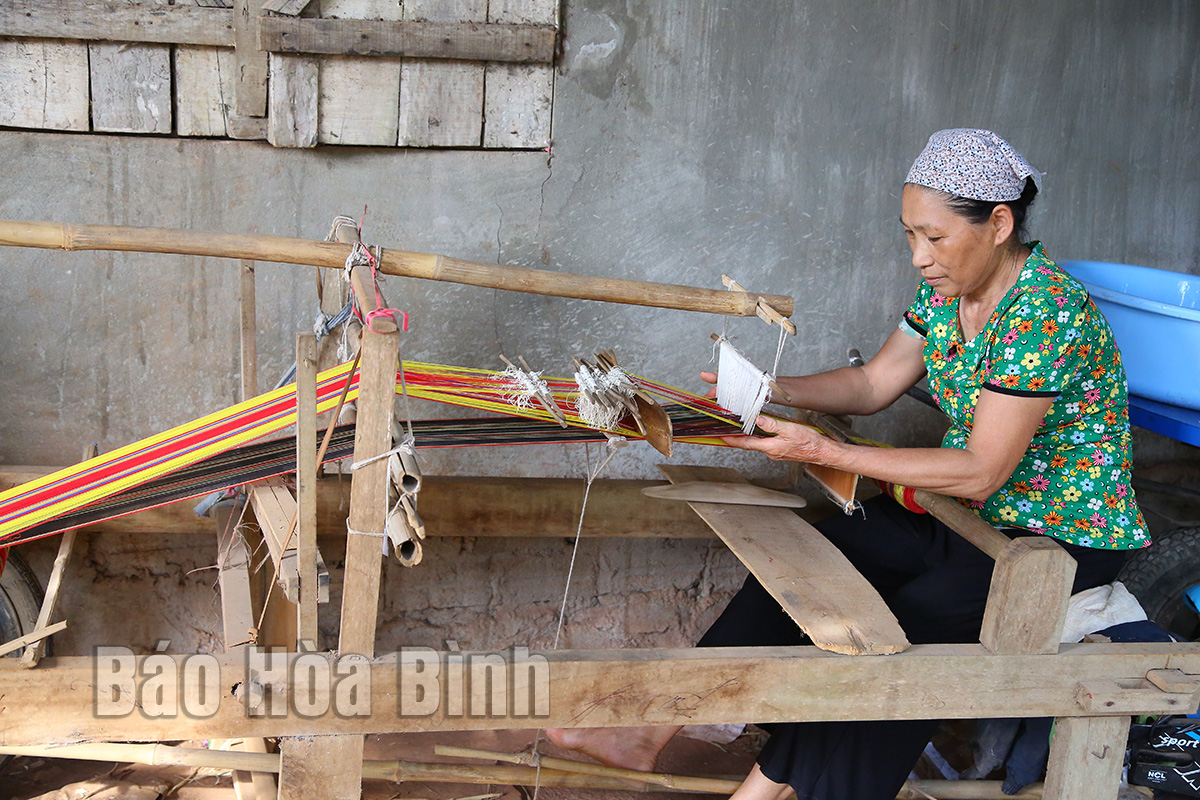
(HBO) - With the love and desire to preserve the cultural beauty left by the great grandfathers, Ms. Bui Thi Huong from Com hamlet, Dong Lai commune (Tan Lac) has been working for nearly 50 years with the traditional brocade products of Muong ethnic group.
Ms. Bui Thi Huong from Com hamlet, Dong Lai commune (Tan Lac) has been working for nearly 50 years with the traditional brocade weaving.
Ms. Bui Thi Huong has brought her love and enthusiasm to preserve and develop the traditional handmade brocade products of Muong people, both serving the needs of the family, and combining business to get additional income at the same time.
We visited her house when she was plying on the loom weaving with the colorful and patterned brocade sheets. Ms. Huong says: Since I was a child, I have seen my mother and grandmother weaving. After that, I was guided by my mother and grandmother in the first steps in order to learn the profession to follow in the greatfathes’s footsteps. In the past, the people grew cotton to spin yarn for weaving, now the yarn is mainly taken from the factory, and the quality is still guaranteed. The products made are mainly the traditional brocade costumes of Muong ethnic people, in addition, there are blankets, pillows and other household items. As it is hand-woven, the the products are of better quality and they are more durable than the machine-woven products. In fact, the ready-made goods with many fabrics, and they are diverse in forms and designs, and they sometimes overwhelm the traditional brocade weaving products. As a result, I and the other people in the village have the fear of losing our nation's brocade weaving. Therefore, I am always thinking and worrying about the ways to preserve and develop brocade weaving in my homeland. The hand-woven products bearing the national cultural identity are brought to consumers, which is a joy that is hard to describe in words.
The traditional costumes of Muong ethnic have many colors, details and motifs such as dragons, phoenixes, deers, birds, etc. Each pattern has its own meaning. Ms. Huong adds: In the past, brocade weaving was only for the family’s need, in recent years it has been produced for business. It needs many people, each with a different stage, from 2-3 days to make a complete costume. Although it takes a lot of time and effort to make, the price is quite low, only 50,000 - 80,000 VND a set depending on the material and the elaborateness. The young people use traditional costumes on holidays, New Year, weddings, and the old people use them every day.
With the desire to preserve the culture of the nation, the Party Committee and the government of Dong Lai commune has proposed the Provincial People's Committee to recognize the traditional brocade weaving village of Com in 2016.
Mr. Bui Van Khoa, the Head of the traditional village of craft brocade weaving says: In the past, there were more than 100 people in the craft village, however, over the time, the old mothers and grandmothers have gradually retired, now there are more than 70 people, they are mainly the elderly, most of the young work in companies because the traditional brocade weaving has not brought high economic value. The young people in the village still have people who want to learn a trade, but not many. Ms. Huong is one of the typical members of the craft village, having participated contributed and supported since the early days of its establishment. Currently, it is still mainly working with passion, wanting to preserve the culture of the nation and above all to guide the young people so that it is not lost. The products mainly serve the needs of use, not bringing much economic efficiency because they have not been widely disseminated.
Mr. Bui Van Thanh, the Vice Chairman of the People's Committee from Dong Lai commune says: Over time, the traditional brocade weaving has gradually disappeared. The commune wishes to receive support from all levels to maintain, preserve and develop the traditional occupations that bring economic value and income, improving the people's lives, and contributing to the local socio-economic development.
Phong Phu commune, Tan Lac district of Hoa Binh province, is widely regarded as the cultural heartland of the Muong ethnic group. Among its many traditional communities, Luy Ai hamlet (formerly Ai hamlet) stands out as a rare location where the customs and way of life of the Muong Bi people remain largely intact.
The Truong Kha temple festival, a distinctive cultural event held every three years in Vu Ban township, Lac Son district, returned recently with vibrant rituals and folk traditions of the Muong people. Located next to the Buoi River in the Muong Trao fields, the Truong Kha Temple is dedicated to the three Kun Dol deities, revered for teaching farming techniques, irrigation, weaving, and protecting the harvest.
The demand for spaces serving community activities of residents in various areas across Hoa Binh city has been satisfied as local cultural houses now feature modern, spacious facilities thanks to the effective implementation of Resolution No. 49/NQ-HDND issued on December 28, 2021 by the city People's Council, which approved the plan for reorganising, converting, and allocating land for the construction, repair, and expansion of cultural houses in Hoa Binh’s villages and residential areas until 2025.
At the end of May, the Hoa Binh Provincial Ethnic Arts Troupe organized a series of performances for residents in Region 2 and Region 3 communes across the province. Bringing art to ethnic communities in remote, isolated, and especially disadvantaged areas has become a meaningful activity. These are not merely artistic performances but also journeys to disseminate cultural values, enrich spiritual life, and contribute to preserving the cultural identity of ethnic minorities.



